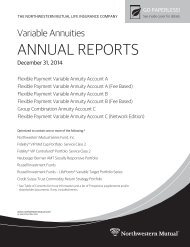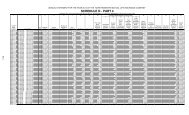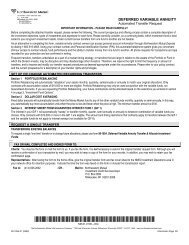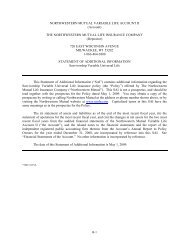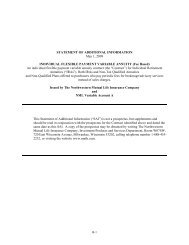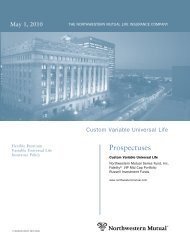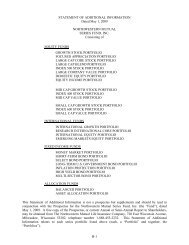B-1 STATEMENT OF ADDITIONAL INFORMATION Dated May 1 ...
B-1 STATEMENT OF ADDITIONAL INFORMATION Dated May 1 ...
B-1 STATEMENT OF ADDITIONAL INFORMATION Dated May 1 ...
Create successful ePaper yourself
Turn your PDF publications into a flip-book with our unique Google optimized e-Paper software.
similar to the arrangements of ADRs. EDRs, in bearer form, are designed for use in European securitiesmarkets.Depositary Receipts are generally subject to the same sort of risks as direct investments in aforeign country, such as, currency risk, political and economic risk, and market risk, because their valuesdepend on the performance of a foreign security denominated in its home currency. The risks of foreigninvesting are addressed in some detail in the Portfolios’ Prospectus.Short SalesThe Portfolios may engage in short sales. In a short sale transaction, a Portfolio sells a security itdoes not own to a purchaser at a specified price. To complete a short sale, a Portfolio must: (1) borrow thesecurity to deliver it to the purchaser and (2) buy that same security in the market to return it to the lender.A Portfolio may sell securities short only on a fully collateralized basis, as permitted by SECinterpretations. At the time of a short sale, a Portfolio will establish and maintain a segregated accountconsisting of liquid assets equal in value to the purchase price due on the settlement date under the shortsale period. The value of the liquid assets will be marked to market daily. A Portfolio may engage in shortsales when its portfolio manager anticipates that the security’s market purchase price will be less than itsborrowing price. Short sales involve the same fundamental risk as short sales against the box, as describedin the paragraph below. In addition, short sales carry risks of loss if the value of a security sold shortincreases prior to the scheduled delivery date and a Portfolio must pay more for the security than it hasreceived from the purchaser in the short sale. To the extent a Portfolio engages in short sales, it may incurinterest and/or dividend expense. A Portfolio’s ability to use short sales may be further restricted by theAdviser’s imposition of a limit on the amount of interest expense to be incurred by a Portfolio. The totalmarket value of all of a Portfolio’s short sale positions will not exceed 5% of its net assets. This limitationon short sale positions does not include, or apply to, other instruments in which a Portfolio may invest(e.g., derivative contracts, inverse ETFs or hybrid instruments) which may produce investment results thatare economically similar to short sales.Each Portfolio may also engage in “short sales against the box.” This technique involves sellingeither a security that a Portfolio owns, or a security equivalent in kind and amount to the security soldshort that the Portfolio has the right to obtain, for delivery at a specified date in the future. A Portfoliomay enter into a short sale against the box to hedge against anticipated declines in the market price ofportfolio securities. If the value of the securities sold short increases prior to the scheduled delivery date,a Portfolio loses the opportunity to participate in the gain.Hybrid InstrumentsHybrid instruments can be an efficient means of creating exposure to a particular market, orsegment of a market, with the objective of enhancing total return. Each of the Portfolios (except for theMoney Market Portfolio) may invest in hybrid instruments. Hybrid instruments have recently beendeveloped and combine the elements of futures contracts or options with those of debt, preferred equity ora depository instrument. Normally, a hybrid instrument may be a debt security, preferred stock,depository share, trust certificate, certificate of deposit or other evidence of indebtedness on which aportion of or all interest payments, and/or the principal or stated amount payable at maturity, redemption,or retirement is determined by reference to prices, changes in prices, or differences between prices ofunderlying assets such as, for example, securities, currencies, intangibles, goods, articles or commodities.Alternatively, interest and/or principal or stated amounts payable may be determined by reference to abenchmark such as, for example, another objective index, economic factor, or other measure, interestrates, currency exchange rates, or commodity or securities indices. Because of these structuraldifferences, hybrid instruments may take a variety of forms, including, but not limited to, debtinstruments with interest or principal payments or redemption terms determined by reference to the valueof a currency or commodity or securities index at a future point in time, preferred stock with dividendrates determined by reference to the value of a currency or commodity or securities index at a future pointin time, preferred stock with dividend rates determined by reference to the value of a currency, orconvertible securities with the conversion terms related to a particular commodity. Hybrids may alsoB-31



